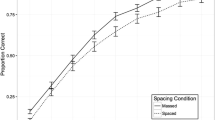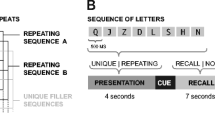Abstract
Two hypotheses suggested by a frequency theory of verbal discrimination learning were investigated: (a) than an increase in study time would facilitate acquisition of a verbal discrimination list; and (b) that increasing familiarization with stimulus materials prior to training would retard acquisition rate of a verbal discrimination list. Study intervals of 2 and 4 seconds were factorially combined with verbal discrimination pairs of high and low frequency. Free recall learning was employed to produce frequency differentials among discrimination pairs. No evidence was found to support the hypothesis regarding a possible relationship between study time and verbal discrimination acquisition. A significant effect in speed of acquisition due to differential frequency was obtained, indicating faster learning of low frequency pairs.
Similar content being viewed by others
References
ARCHER, E. J. 1960. A reevaluation of the meaningfulness of all possible Cvc trigrams. Psychological Monographs, 74, (10, Whole No. 497).
EKSTRAND, R. R., WALLACE, W. P., & UNDERWOOD, R. J. 1966. A frequency theory of discrimination learning. Psychological Review, 73 (6), 566–578.
POSTMAN, L. 1963. The effects of language habits on the acquisition and retention of verbal associations. Journal of Experimental Psychology, 64, 7–19.
RUNQUIST, W. N., & FREEMAN, M. 1960. Roles of association value and syllable familiarization in verbal discrimination learning. Journal of Experimental Psychology, 59, 396–401.
THORNDIKE, E. L., & LORGE, I. 1944. The teachers word book of 30,000 words. New York: Rureau of publications. Columbia University.
UNDERWOOD, R. J., & FREUND, J. S. 1968. Two tests of a theory of verbal discrimination learning. Canadian Journal of Psychology, 22 (2), 96–104.
WINER, B. J. 1962. Statistical principles in experimental design. New York: McGraw-Hill.
Author information
Authors and Affiliations
Additional information
This report is based on a dissertation submitted to the Graduate School of the University of North Dakota in partial fulfillment of the requirements for the Ph.D. degree. The author is indebted to Dr. J. C. Koeppel and Dr. R. H. Kolstoe for their comments and suggestions at all stages of the research.
Rights and permissions
About this article
Cite this article
Skeen, D.R. Study Interval, Manipulated Frequency, and Verbal Discrimination Learning. Psychol Rec 20, 111–117 (1970). https://doi.org/10.1007/BF03393918
Published:
Issue Date:
DOI: https://doi.org/10.1007/BF03393918




